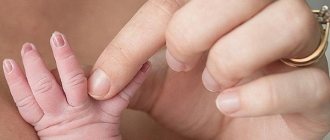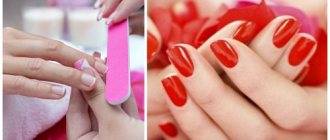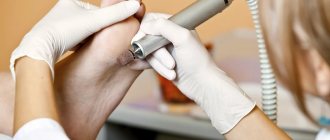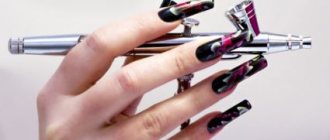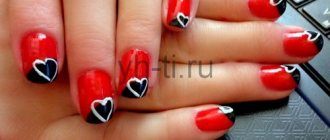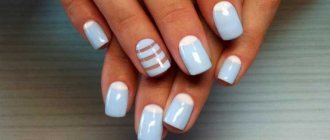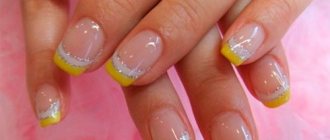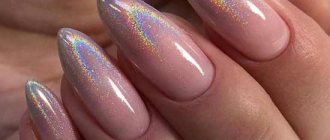Causes of nail dystrophy or onychodystrophy
Nails do not receive enough nutrition for various reasons. Among them:
| • Mechanical injury to the nail plate. • Weakened immunity due to previous infectious diseases. • Nail fungus infection. • Hormonal imbalance in the body. • Mental disorder. • Exposure of the nail to chemicals. |
The disease nail dystrophy has several varieties. Therefore, external manifestations are different. Let's consider the main ones in order to recognize the disease in time and immediately begin to fight it.
Median canal nail dystrophy
The nails of the thumbs are usually affected. A longitudinal groove appears on the nail plate, with small cracks spreading out to the sides. As a result, the nail becomes wavy.
Most often, pathology occurs due to mechanical injury. Usually these are unconscious actions of the patient: biting or constantly pinching the nail. This behavior may be a bad habit, but it may well be a neurological disorder.
It is extremely rare that canal-shaped dystrophy is transmitted genetically.
How to get rid of it?
Complex treatment of dystrophy with medications is necessary
First of all, it is necessary to correct the person’s mental state. The difficulty is that the patient usually denies his involvement in the mutilation of his own nail. Therefore, it is better to carry out treatment under the supervision of a neurologist.
The main success factor is the cessation of mechanical impact on the nail. Therefore, fingers with damaged nails should be bandaged. At the same time, measures are taken to strengthen the nail plate: using nourishing creams and varnishes, taking vitamins.
Wikipedia article about this disease
Treatment
Before starting treatment
onychomadesis, a comprehensive examination is carried out in order to select the necessary drugs that will immediately affect the root cause of the disease and the processes generated by it in the body, and not just the nail plate itself. But the primary task remains the restoration of the matrix, without which the nail will never recover. To do this, local blood circulation is artificially activated and, if necessary, damaged nerve fibers are restored.
If the cause of the disease is mechanical damage, then massages, vitamins and chondroprotectors are recommendations for treatment.
Correct determination of the cause of the disease is the key to successful treatment. So, for a fungal infection, treatment is aimed at eliminating the fungus, and for psoriasis, the psoriasis itself is treated. If the cause of the nail damage is a bacterial infection, both local and systemic antibacterial drugs are used. Drops are used to treat nails.
When the cause is correctly identified, the nail begins to slowly recover. But this process takes quite a long time.
In some cases, surgery is used to save the affected nail, but it is not always possible or effective.
The use of traditional medicine for the treatment of onychomadesis
Treatment with natural remedies is carried out only in parallel with medication, however, it is used as a preventive measure and is beneficial for nails.
The most popular natural remedy is salt baths . In some cases, a few drops of iodine are added to the solution. It is better to use sea salt. You can give your fingers such baths 1-2 times a day for a couple of months. Used as a prophylaxis and to stop the growth of fungal and bacterial microflora in the nails. Baths are used for both hands and feet.
Oils. It is better to use sea buckthorn. But olive oil is also suitable. Add two to three drops of your favorite essential oil. A couple of drops will be enough. They need to treat the sore nail, put on cotton gloves and leave it until the morning. Cotton pads will make the process a little easier. This composition of oils stimulates the regeneration process and has an anti-inflammatory effect.
Alum compress . Mix 20-30 ml of glycerin, 5 g of alum and a quarter glass of water. Soak a bandage folded in several rows with the mixture, apply it to the damaged nail, wrap it in film, and wrap it with a bandage on top. This compress can be applied before bed and removed in the morning.
Pine needles . Add one part of chamomile herb to one part of the pine needles, pour a glass of boiling water, leave for 1 hour. Then add a glass of warm green tea. It is important not to let the mixture cool. Lower your fingers and hold for about half an hour. The needles contain a large amount of essential oils, and the chamomile infusion fights bacteria. The mixture perfectly prevents the occurrence of infections.
Pumpkin. Make a paste from fresh pumpkin (a blender or meat grinder helps), add a spoonful of olive oil. Spread the resulting mixture generously onto the affected nail and wrap it in a plastic bag and a bandage on top. Leave overnight. In the morning, rinse with warm water.
Reference.
Traditional medicine is aimed mainly at eliminating inflammation and reducing the activity of fungal manifestations. You should not rely only on it, since the causes of the disease lie much deeper and cannot be eliminated at home.
Gapalonychia
This type of nail dystrophy manifests itself as softening and thinning of the nails, which leads to their fragility.
The disorder can develop due to internal problems in the body (true hapalonychia). But it happens that it occurs due to external influences on the nails (acquired hapalonychia).
Causes: Hapalonychia occurs due to diseases such as:
• Arthritis • Problems in the gastrointestinal tract • Peripheral vascular diseases • Thyroid diseases
True hapalonychia is possible with hereditary predisposition and poor nutrition. Softening of the nails is caused by a lack of vitamins A and B, as well as a deficiency of iron, sulfur, and calcium.
| Acquired hapalonychia occurs when exposed to household chemicals or injured nails. Injury is possible if manicure is performed incorrectly or if extended nails are used for a long time. |
How to treat hapalonychia or nail dystrophy?
• Do house cleaning only with rubber gloves. • If the nail has been damaged, protect it from re-injury. After some time, the unhealthy nail will grow back and the problem will go away on its own. • Avoid using extended or false nails. • Eat more fruits and vegetables. Moderate your intake of fatty and sugary foods. Pay attention to your chronic diseases - and treat them first.
Onycholysis or nail detachment
This disease is characterized by the detachment of the nail from the nail bed . An empty space forms between the soft tissue and the nail plate. The color of the nail changes to grayish-yellow. An unpleasant odor appears.
| The cause of such dystrophy can be a fungal disease . In this case, the disease quickly covers all fingers, capturing the skin between them. |
But often onycholysis is acquired through non-infectious means. Nail injuries, exposure to household chemicals, taking antibiotics, impaired blood supply to the fingers - all this can cause the disease.
Chronic diseases of the cardiovascular system, gastrointestinal tract, nervous and endocrine systems can also provoke the disease.
How to get rid of it?
• If the nail deformation occurs due to injury, trim the nail plate short until the damaged area disappears.
• Cover the unhealthy nail with an antibacterial bandage to prevent it from becoming infected.
• Take care of chronic diseases.
• If you took antibiotics, check for intestinal dysbiosis. Heal him first.
• Protect your nails from contact with washing powders and chemical cleaners. When cleaning, only wear rubber gloves.
• If the cause is a fungal infection, then you cannot do without visiting a specialist. Only a doctor will prescribe the necessary medications. Treatment can last quite a long time.
Onychorrhexis
The main symptom is longitudinal splitting of the nail . There may be several cracks. At the beginning of the disease they are almost invisible, but later they become deeper.
| Split nails are more common in older people . This occurs due to impaired blood microcirculation and chronic diseases: diabetes, psoriasis, thyrotoxicosis, systemic atherosclerosis. |
Onychorrhexis can be by improperly performed manicures , the use of varnishes containing acetone, and frequent contact with household chemicals.
How to treat?
A visit to a dermatologist is mandatory. The doctor will identify the root cause and select the correct treatment. Usually prescribed:
• Drugs that normalize blood microcirculation. • Means for strengthening the walls of blood vessels. • Vitamins, minerals and amino acids. • Massage. • Physiotherapy.
Onychoschisis
In this case, the nail plate delaminates and splits , and transverse cracks form. The color of the nail plate takes on a gray or off-white tint.
A common cause is direct contact with nails with household chemicals. Alkaline solutions are especially dangerous.
Cheap nail polishes and solvents containing acetone also cause harm.
Another reason for delamination can be improper handling of a nail file or the use of too rough manicure tools.
Treatment of nail dystrophy – onychoschisis.
Treatment is aimed at restoring nutrition and strengthening the nail plate . Only a doctor can prescribe the necessary medications. Treatment includes massage and physiotherapy. For better nutrition of the nail, complexes of vitamins and minerals, unsaturated fatty acids, and amino acids are prescribed.
General strengthening and sedatives are used to enhance immunity.
| Taking retinol and edible gelatin helps. Baths with sea salt have a healing effect. |
Treatment with traditional methods
Traditional therapy is often used to treat a variety of diseases of the nail plate. Useful herbs, baths and other methods of therapy can be used in parallel with the main treatment.
Baths
There are several good recipes that help restore the nail or promote the growth of a healthy plate. When performing baths, you need to keep your hands or feet in the water for at least 10 minutes, repeat the therapy once a day for up to 10 days:
- Mix equal parts pine needles and chamomile flowers. Pour 2 tablespoons of raw material into 300 ml of water and leave for an hour. After combining with 100 ml of prepared green tea, pour the product into the water.
- Mix equal amounts of celandine, chamomile, nettle, horsetail, string, and plantain. Brew 3 tablespoons of raw material with a liter of water and make a bath.
- Combine 500 ml of dry red wine with 1 tablespoon of sea salt. Dip your nails into the product. Instead of salt, you can add honey or butter to wine.
- Dissolve 5 g of alum and 20 ml of glycerin in a liter of water and make a bath. You can make a compress with the same mixture, but in a smaller volume of water.
- Dilute gelatin in water (a tablespoon per 250 ml), hold your fingers in it.
Iodine and propolis
Mix 10 drops of propolis and iodine tincture. Treat affected nails with the product if the cause of the problem is a fungus. Repeat therapy three times a day until recovery.
Iodine and orange
This folk recipe is used against splitting nails. Squeeze orange juice (100 ml), add 5 drops of iodine, add a teaspoon of salt, add 100 ml of mineral water. Leave your nails on for 10 minutes.
Oil masks
If your nails have suffered from onychomadesis, there are wounds around them, or the nail plate has already completely peeled off, it is recommended to apply oil rubs and masks. You need to add 5-10 drops of tea tree oil, rosemary, ylang-ylang to 50 ml of any base oil. Lubricate your fingers, put on gloves, and leave overnight.
Pumpkin mask
Peel the young pumpkin from the peel, seeds, and make the pulp using a blender. Add a little olive oil, apply to the nail, wrap with film and bandage. Leave overnight.
Beau-Reil's furrows
They look like dense arched grooves . They pass through the entire nail plate between the lateral ridges of the nail. The depth of the furrow reaches 1 mm. The color of the nail does not change. If there are several grooves, the nail becomes wavy.
In severe cases, the Beau-Reil groove deepens and divides the nail into two parts. The distant half is subsequently completely separated.
The reasons for the appearance may be different:
• Injuries, including from cosmetic procedures. • Presence of skin diseases of the fingers and nails: fungus, eczema, psoriasis. • Frequent stress. • Infectious diseases. • Heat. • Food poisoning. • Previous myocardial infarction.
How to get rid of it?
Beau-Reil's furrows are not considered a separate disease. Their presence is the result of a malfunction of the nail matrix. Therefore, the furrow that appears does not need to be treated . She'll get off on her own. However, it is worth paying attention to the reason that caused the deformation of the nail. And only a doctor can do this. So you will have to see a dermatologist.
| The doctor will prescribe an examination by related specialists: cardiologist, endocrinologist, gastroenterologist, allergist. They will prescribe the correct treatment. |
"Thimble" nail
Numerous pinpoint depressions appear
on the nail plate . In appearance, the nail resembles a thimble.
This pathology is also not an independent disease. It manifests itself in advanced forms of seborrhea or focal alopecia.
How to get rid of it?
The main efforts are directed to the treatment of major diseases. Nails must be maintained and strengthened with healing masks and baths.
Prevention
It is almost impossible to prevent the appearance of onychomadesis after a viral illness. As with injuries. But, nevertheless, it is possible to reduce the risk of infection through basic hygiene. It is important to wear only your own shoes and wash your feet and hands regularly. Maintain full immunity and consult a doctor on time. With timely diagnosis and competent treatment, the disease does not pose a great threat, although it requires a lot of patience to recover.
Nail dyschromia
Characterized by a change in the color of the nail plate . The nail may completely change color, and individual spots and stripes may appear from white to black.
One of the reasons is nail injury. Gray, brown, yellow shades occur under the influence of chemicals and certain types of medications.
Discoloration sometimes occurs as a consequence of an existing disease.
How to get rid of it?
Seeing a doctor is mandatory . In addition to a dermatologist, you may need to consult an endocrinologist, cardiologist, pulmonologist, nephrologist. Treatment is prescribed only by a doctor based on the results of the examination.
Clinical course of the disease
Onychomadesis manifests itself for some time (before the nail falls off) in this way:
- The color of the nail plate changes (turns yellow or white, may become cyanotic);
- The shape of the nail changes;
- The skin under the nail may thicken or become inflamed (with the bacterial nature of onychomadesis).
With onychomadesis, the nail separates from the finger, turns yellow, and takes on an unnatural shape.
The nail is torn off either from the distal side (free) or from the base - depending on the reason that caused onychomadesis.
The tissue surrounding the nails may become inflamed, which is typical for mycoses and bacterial infections.
Inflammation most often accompanies the removal of the nail from the proximal (inner) side of the nail - the finger hurts, the skin around it turns red. The process may involve the entire hand or foot.
With psoriasis and leprosy, the nail comes off painlessly from the distal end.
If the nail falls off completely, the finger will become an easy target for infections and fungus.
After the nail comes off, the bed is exposed, on which a fungus or bacterial infection “happily” settles. If infection of the bed is not prevented in time, the nail matrix is completely destroyed by bacteria or fungi, after which a normal nail on this phalanx will never grow.
Even if the nail has completely collapsed and fallen off, it is necessary to visit a dermatologist to prevent or treat the infection.
Onychomycosis
This is a fungal infection. There are three types of onychomycosis:
• normotrophic • hypertrophic • atrophic (onycholytic)
With normotrophic onychomycosis, only the color of the nail changes. Stripes and spots of white or yellowish-gray color appear along the edges. Over time, the entire nail changes color.
With hypertrophic onychomycosis, the nail changes color, becomes dull, thickens and collapses on the sides.
With atrophic onychomycosis, the nail becomes brownish-gray, the nail plate becomes thinner and is rejected. The exposed area of the finger is covered with a loose growth.
And infection occurs in damp public places: saunas, baths, swimming pools. Skin flakes containing pathogenic fungi fall off the feet of an infected person. In a humid environment, fungi persist for a long time, multiply and infect other people.
Within a family, the fungus is transmitted by sharing shoes, washcloths, and towels.
| The fungus usually affects the toes. Infection of fingernails occurs as a result of scratching the infected areas. |
How to get rid of it?
Topical ointments are ineffective when it comes to damage to the nail plate. An unhealthy nail must first be softened with a keratolytic patch. After this, it can be easily removed mechanically using scissors.
"Manicure" nail dystrophy
The nail is covered lengthwise and crosswise with white stripes. Beau-Reil's furrows appear. The nail plate peels off, becomes wavy and rough.
The main reason is careless handling of the nail fold and nail plates during cosmetic procedures. Especially if manicures and pedicures are performed frequently.
The use of varnish and solvents containing acetone also damages and dehydrates the nail.
Treatment of manicure nail dystrophy:
Avoid traumatic cuticle trimming procedures . Use a safe unedged manicure. In this case, the cuticle is not cut. It is softened using a special product based on lactic or fruit acid. Then it is painlessly removed.
Do not wear nail polish, extensions, or false nails. Give your nails a temporary rest. Strengthen them with healing masks, compresses and baths.
Strengthening the nail plate at home
At home, your doctor may recommend strengthening the nail plate using folk remedies.
Simple recipes will help you quickly restore and grow beautiful nails.
Lemon and oil
A strengthening mask is prepared using sunflower or olive oil with the addition of lemon juice.
- Heat one tablespoon of oil to room temperature and add a few drops of lemon.
- You can add 2-3 drops of essential oils, such as tea tree or rosemary, to this oil base, which will saturate the cuticles with nutrients.
- Rub the resulting mixture into your nails.
- After 20–30 minutes, blot with a clean napkin.
The procedure should be carried out every three days for one to two months.
Recipes based on lemon and oil are given in the video:
Red pepper
- Mix 2 grams of crushed red pepper with 10 drops of clean water and 1 tsp. nourishing cream. Mix everything thoroughly.
- Steam your nails in warm water and apply the resulting product to the surface.
- After 15–20 minutes, rinse off the mask with warm water.
A mask with red pepper perfectly stimulates the growth of the nail plate.
Apply once every 30 days.
The recipe for such a nail mask is shown in the video:
Wax
Natural beeswax helps restore the integrity of the nail and nourishes it.
- 1 tsp. melt the wax in a water bath, add 1 yolk of a hard-boiled chicken egg and a few drops of vegetable oil (for example, olive, sunflower, peach). The resulting mixture should be paste-like.
- Dip your fingers into the wax mixture and hold for 2-3 minutes.
- After 30 minutes, remove the wax from the nails.
Carry out the procedure daily for 10 days, then take a break for a week.
Gelatin bath
- Pour one tablespoon of gelatin into one glass of boiling water and stir thoroughly.
- Add the contents of one capsule with vitamins to the cooled solution.
- Dip your nails into gelatin and hold for 10-15 minutes.
Perform the procedure 2-3 times a week until complete recovery.
The video shows the process of preparing and using a gelatin nail mask:
Iodine
Use pharmaceutical tincture of iodine (5%) to treat nail plates . To do this, dip a cotton swab in the solution and apply to the surface. The procedure should be carried out no more than 2 times a day for 20 days. Then take a break for two days and resume the process.
The treatment of nails with iodine is described in the video:
Propolis
Apply propolis tincture (20%) to the affected nail using a cotton pad soaked in the solution. Leave the product overnight. Perform the procedure for 3 days in a row, then take a break.
Sea salt
Dissolve 2 tablespoons of salt in one glass of water heated to 45 °C. Dip your nails into the resulting solution and hold for 15–20 minutes. Take baths with sea salt every other day for a month.
On a note! You should not follow all traditional medicine recipes at the same time. Choose the optimal 2-3 pieces for yourself and alternate them with each other.
The video shows how to make a nail bath with sea salt:
Treatment of nail dystrophy with folk remedies
Traditional medicine is great for restoring unhealthy nails. However, traditional methods are only a good addition to the treatment prescribed by the doctor.
Here you will find the most effective of them:
For 10 days, morning and evening, treat your nails with 5% iodine tincture. A two-day break - and repeat the course again.
At night, apply a compress of 20% propolis tincture to the nail. Do 2-3 procedures. The tincture should not come into contact with the skin, so as not to cause a burn.
Stir 1 tablespoon of edible gelatin in two glasses of water at room temperature. Leave for 40 minutes to swell. Heat, stirring, until completely dissolved. Drink in separate sips throughout the day. The course is one month.
Baths
They should be hot - about 45 degrees. Use different bath options: sea salt, soda, starch, bran, eucalyptus, oak bark.
After taking a bath, gently pat your hands dry with a soft towel and massage the skin around the nail, rubbing in one of the following products: tea tree oil, melted wax, vitamins A or E.
Read more about nail baths.
Oil masks
Steam your fingers. Apply heated essential oil to your nails and surrounding skin. Wrap your fingers in cling film and put on wool mittens. After 15 minutes, massage your nails and the skin around them.
Use oils:
• Lemon. Has antibacterial and healing properties. • Ylang-ylang. Strengthens and prevents delamination. • Eucalyptus. Moisturizes and heals wounds. • Rosemary. Promotes growth.
***
Contact your doctor when the first signs of problems in your body appear.
Eat right. Eat dishes with gelatin: marmalade, jelly, aspic. Dairy products, yeast, soy products, seafood, green vegetables are useful.
| Use strengthening baths and nail masks. Do this regularly as long as your nails are beautiful and healthy. Avoid getting household chemicals on your nails. Do housework wearing rubber gloves. Avoid damaging your nails during manicure. Trust your nails only to a specialist. Do not use cheap varnishes or solvents containing acetone. And then your nails will not cause you problems, but will only delight you with their healthy appearance. |
Diagnostics
The diagnosis of “onychomadesis” can be made by any dermatologist or dermatocosmetologist, but after that the doctor will need to conduct a diagnosis to determine the cause of this condition. This is the only way to determine how to treat onychomadesis. The following studies help to find the cause:
- examination of the nail under a special lamp, which will highlight areas affected by fungi such as Trichophyton;
- taking a section of the nail to examine it under a microscope;
- scraping material from the damaged horny plate to determine a fungal infection;
- scraping the material from the skin around the nail subjected to onychomadesis, followed by its bacteriological examination;
- determination of antibodies to syphilis (blood test for RW - Wasserman reaction), enteroviruses, leprosy;
- You may need to consult a psychiatrist or infectious disease specialist.
